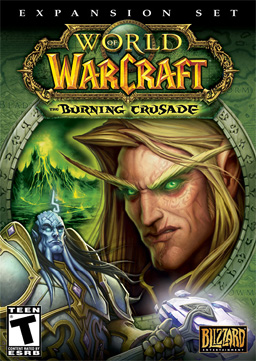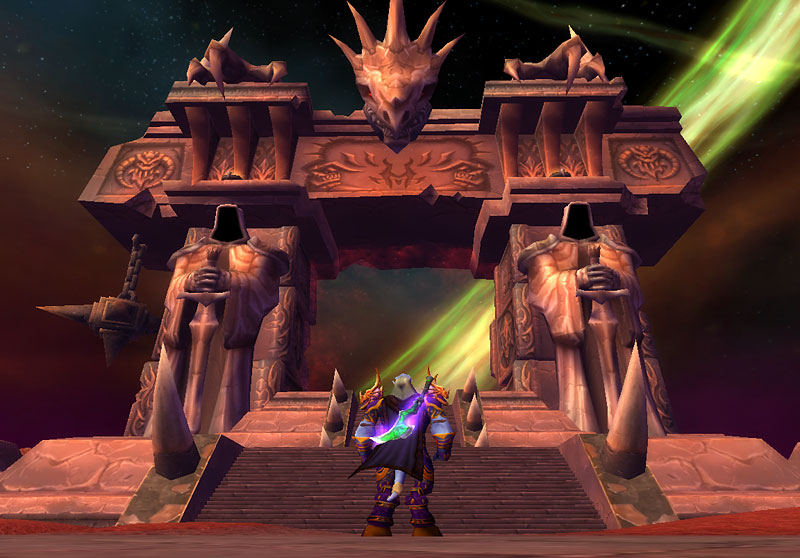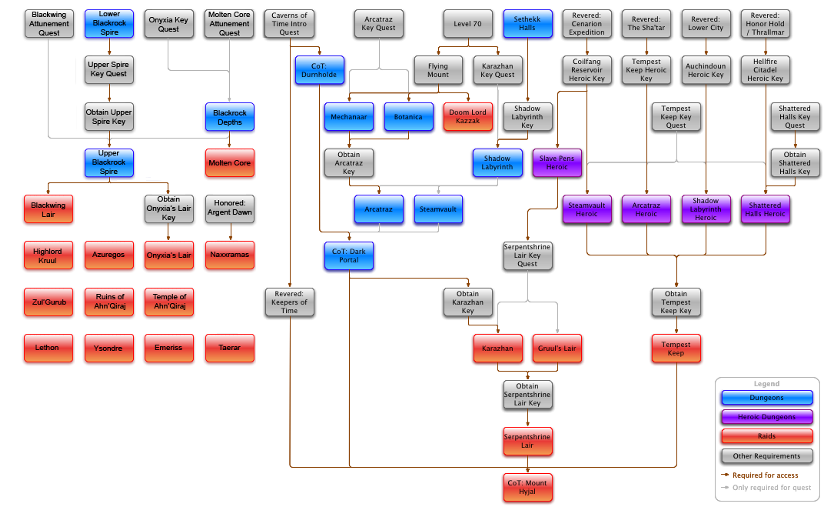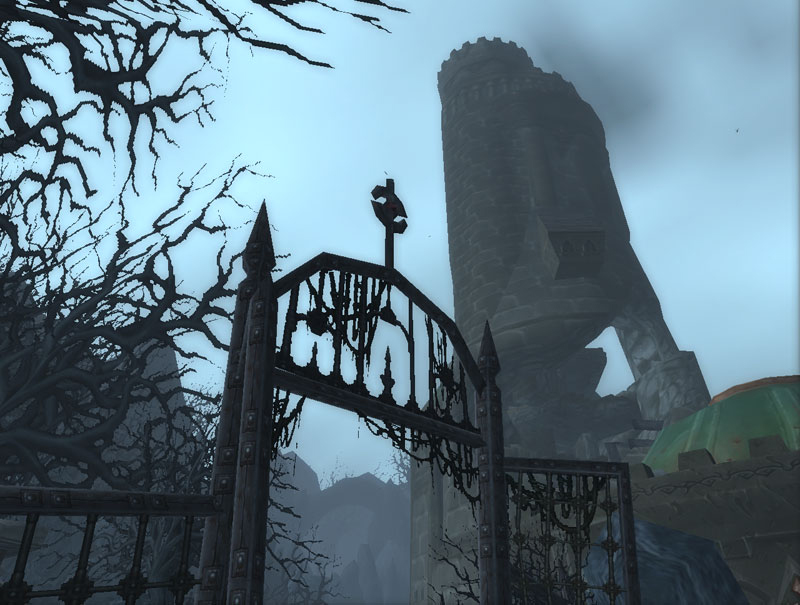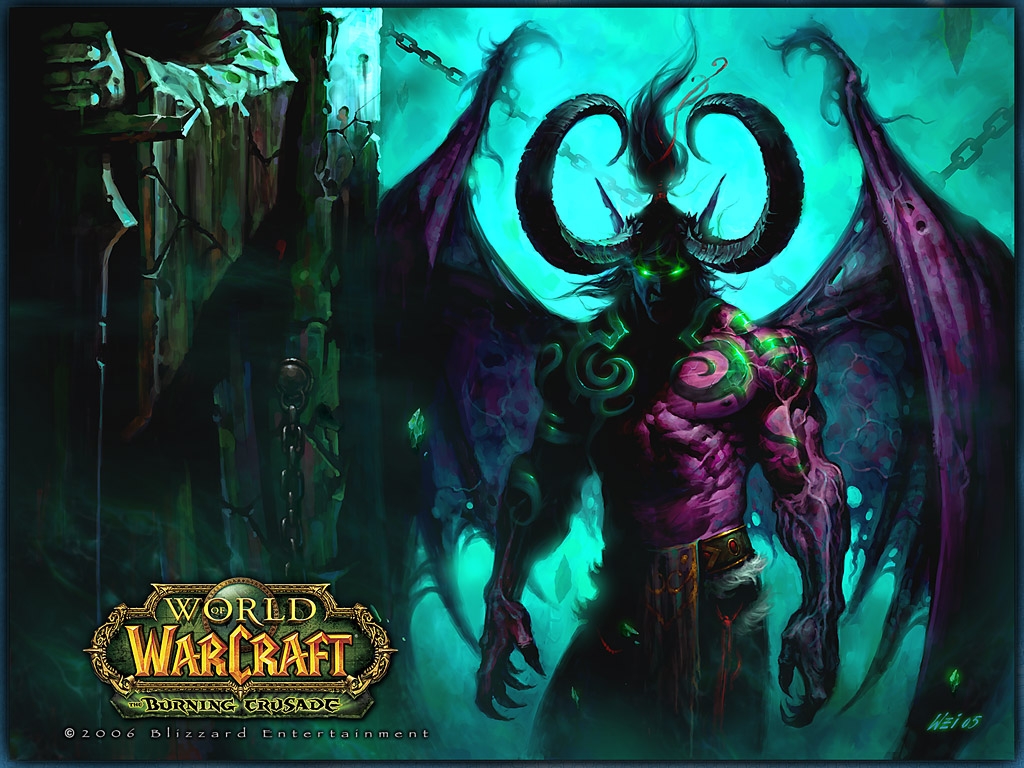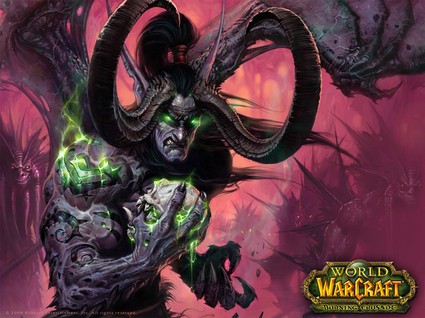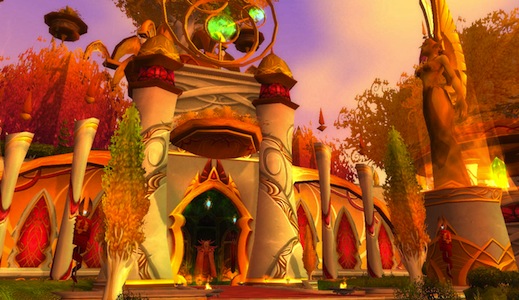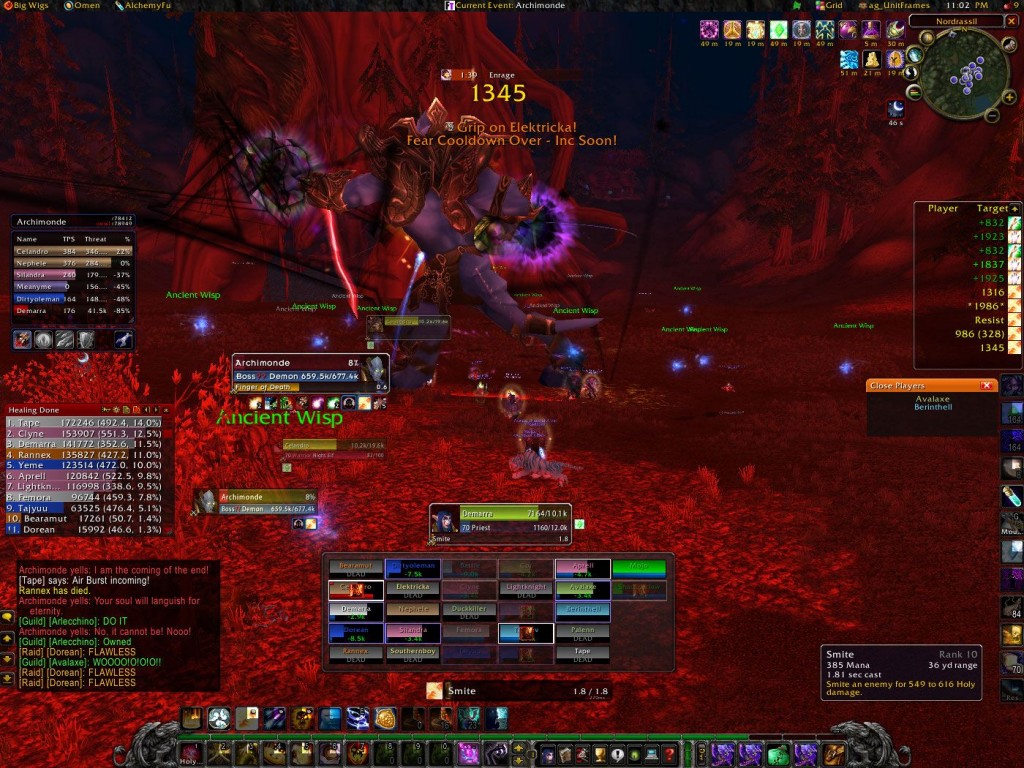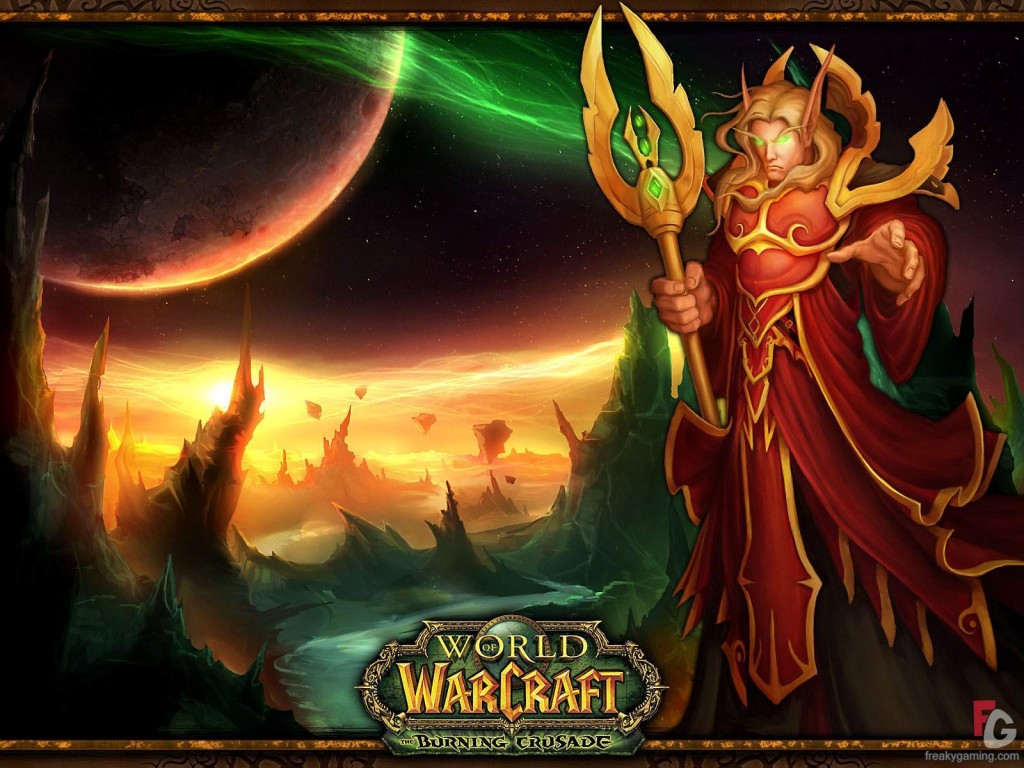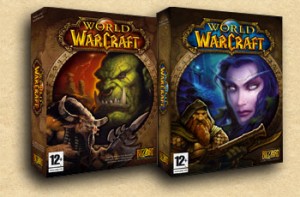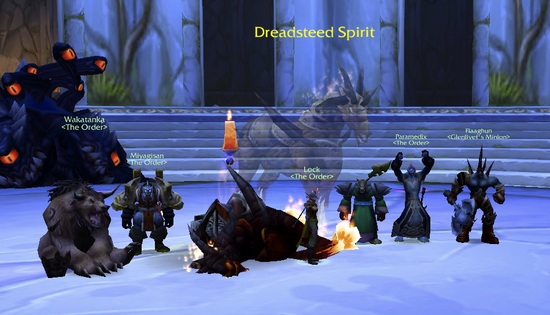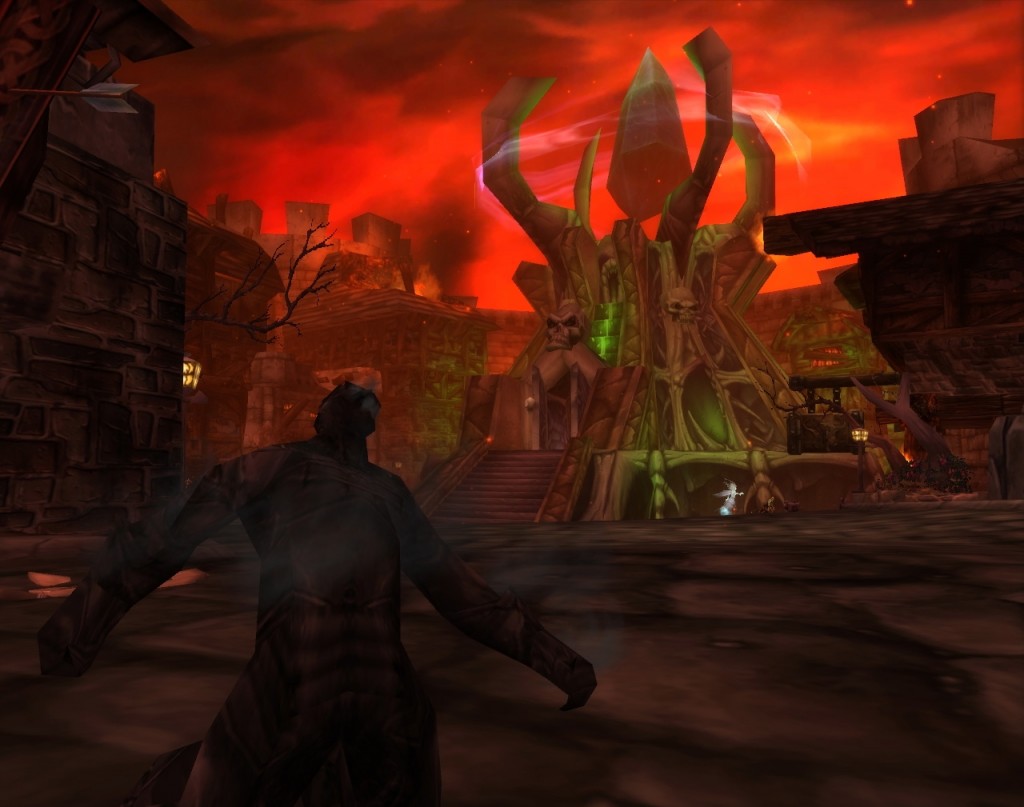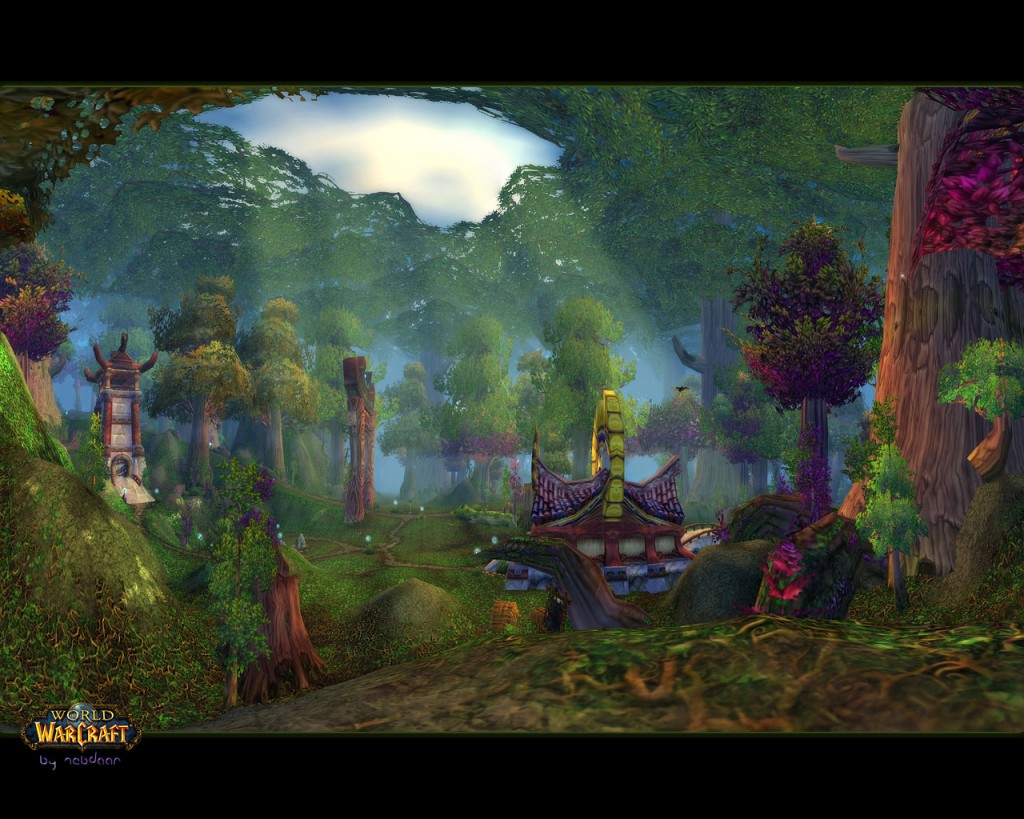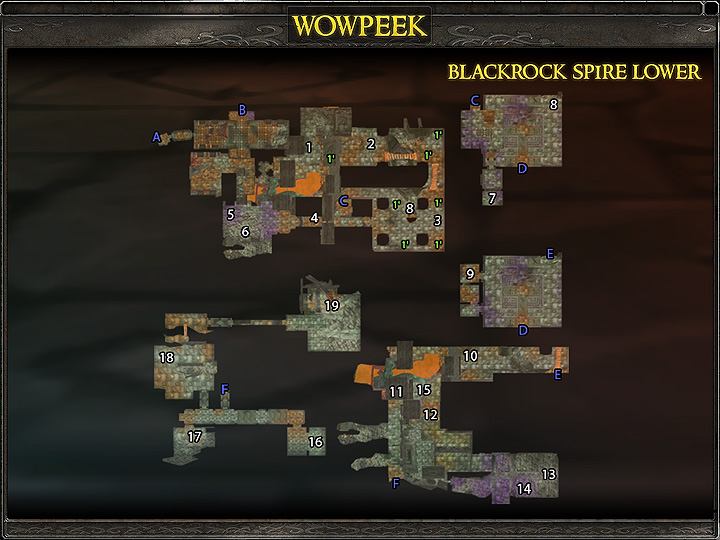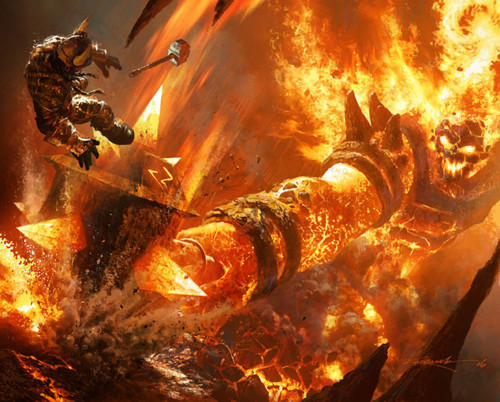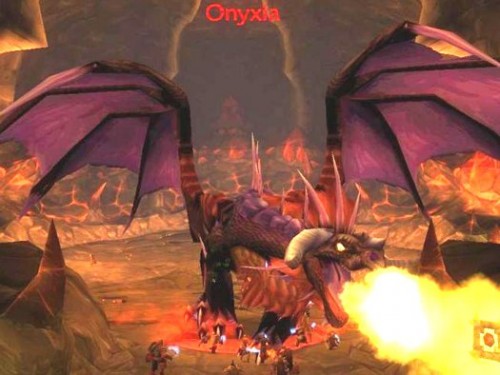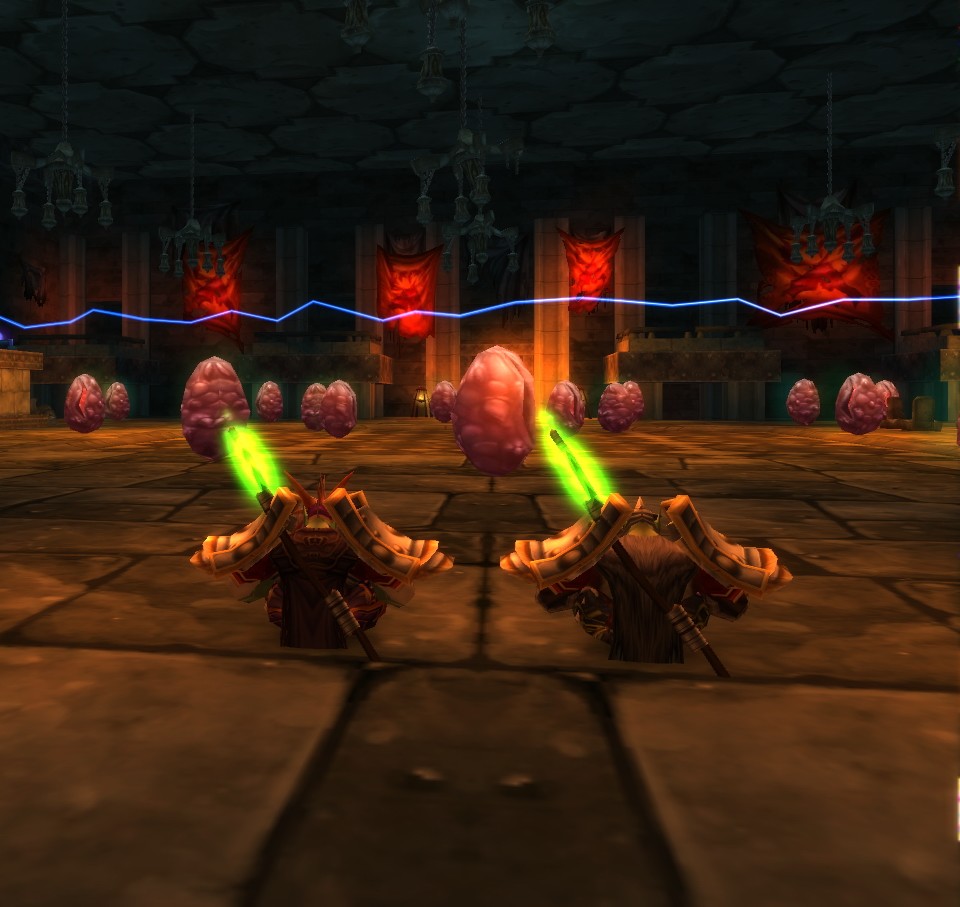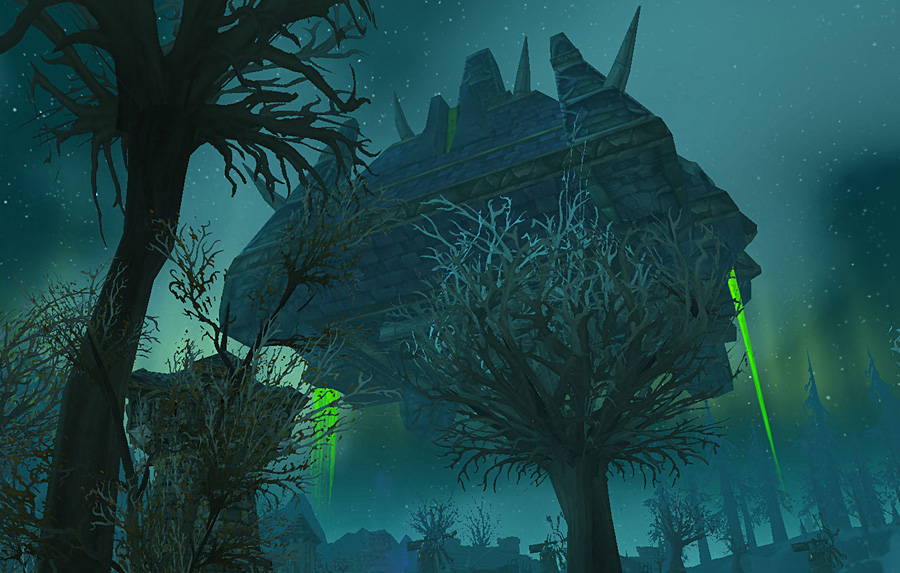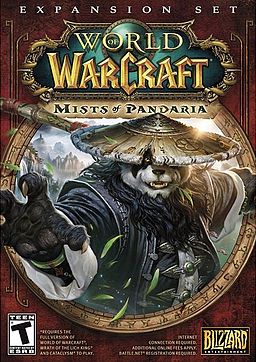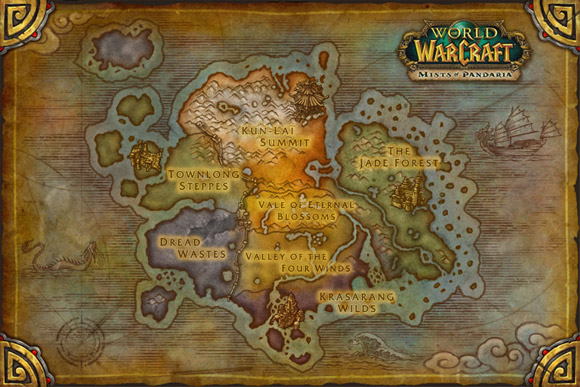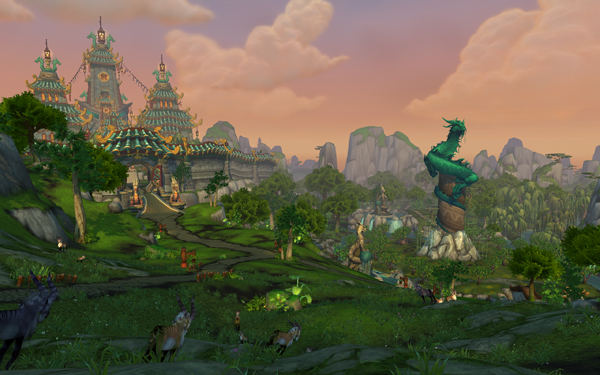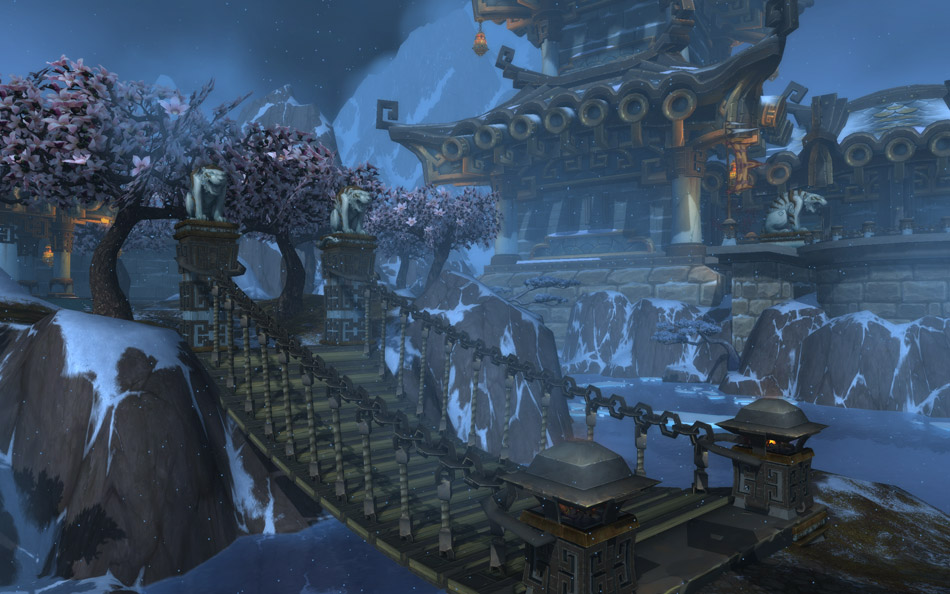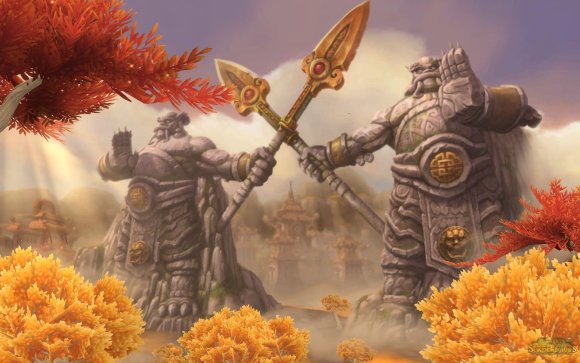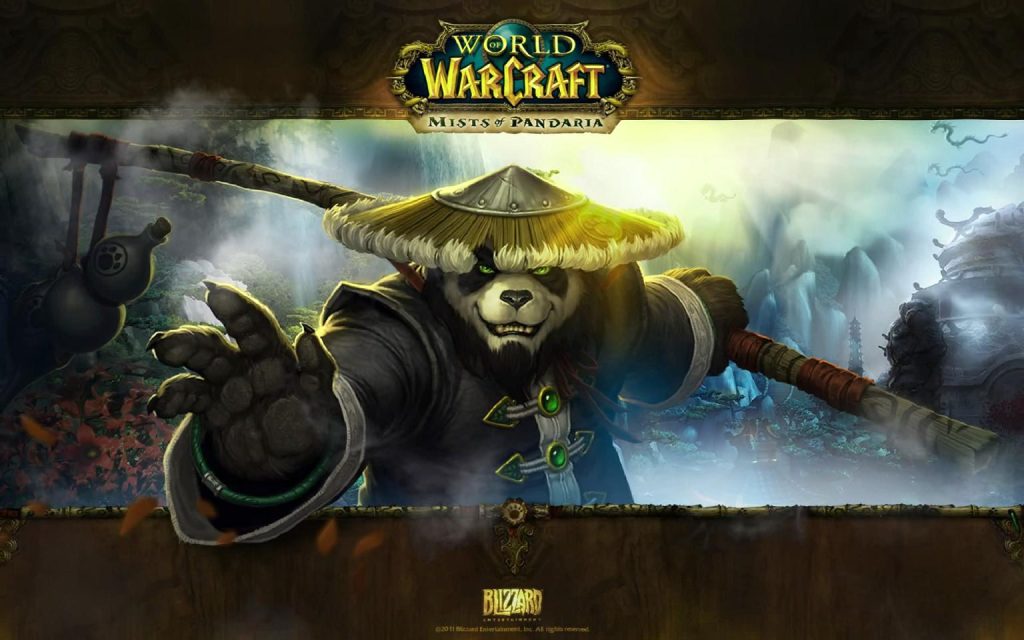…continued from my coverage of the WOW Vanilla endgame.
In January of 2007, Blizzard launched The Burning Crusade, the first of four expansions to World of Warcraft and completely overhauled the endgame. In the race from level 60 to 70, any advantage gained by level 60 raiders was quickly swamped out.
Vanilla introduced the core World of Warcraft gameplay: questing, dungeons, pvp, and raids, but The Burning Crusade (BC) began a long process of inventing and refining new mechanics that doled out rewards for these activities. Most innovations were introduced during the BC and Lich King periods, and the newest two expansions (Cataclysm and Pandaria) have mostly tuned those mechanics. BC represented a lot of innovation, beginning one way (closer to Vanilla) and ending another.
It’s all about the numbers
BC saw radical changes with regard to party size. Ignoring UBRS, Vanilla finished up with a 5, 20, 40 scheme. This meant that dungeons were 5 man, smaller raids 20 man, and big raids 40. BC dropped the odd “big dungeons” (like UBRS) and moved to 5, 10, 25. Dungeons didn’t change, but the small raids moved to 10 man and the big raids to 25. Unlike today, each raid was designed for one size. At launch, there a single “intro raid”: Karazhan and four “big” raids. Two were 1-2 boss raids (Gruul’s Lair and Magtheridon) and two were bigger progression instances (Serpentshrine Cavern and Tempest Keep). 40 man groups persisted vestigially for ad hoc and battleground PVP.
The intent of the shrinking group was to make it easier for guilds to get a raid together. With 10 man, this was successful. 10 man raids had enough people for two tank mechanics and specialized roles, but were easy to recruit and coordinate. I’m not sure the 40 to 25 shift was as productive. 25 man raids were only moderately easier to organize than 40 and certainly felt less epic. On the other hand, Vanilla 40 mans allowed single players to screw up and slip through the cracks. In BC 25 mans, everyone counted.
Questing
BC shipped with 7 big new zones, a new capital city, two new races, and a ton of quests. By the time I hit level 70, I still had two full zones left. However, like Vanilla, the motivation to finish wasn’t extremely high. You got gold and a few decent blues, but it was a lot of work, and there were numerous annoying 5 man quests. The main reason to finish was to open up the complex network of key chains required to raid (more on this later).
Questing in general was a lot better organized. The basic principle of smaller quest hubs located near their objectives was established. There were few long postal quests like in Vanilla. Dungeon quests remained interwoven with long zone based quest chains. This usually meant, like Vanilla, that during leveling you had not opened up the proper chains for many dungeons. Often these lengthy chains that wound in and out of the many dungeons had to be completed at 70.
Split Reputation
Reputation in BC moved from the sidelines to front and center. Each dungeon group had one (or two) associated new reps and each rep gained a more meaningful vendor. The rewards, pathetic in Vanilla, became merely okay, and in the case of a few later reps actually good. Several of the reps gated the acquisition of vital items and buffs. The specifics varied by class and spec, but generally it was necessary to run most reputations to revered, particularly since entry into the new heroic difficulty dungeons also required revered reputation with each dungeon’s specific rep (more on that later). Reputation was earned in two ways: by running dungeons specific to the reputation or by grinding annoying drops.
Important to all classes were two new city reputations (Scryer and Aldor). Blizzard experimented with providing the player with a choice between two similar reps. Both gated important buffs and resistance gear. Any serious raider needed to reach exalted and that required killing thousands of specific mobs to collect rep drops (or you could buy them on the auction house). Since this was the last time the designers tried this “choice of rep”, I can assume it was a failure. It added color, but ultimately was a lot of developer work for what didn’t amount to much variety.
Normal Dungeons
Dungeons remained a major source of loot and were necessary to armor yourself in dungeon blues for entry raiding. Blizzard shortened up the dungeons — slightly. Nothing in BC was as big and as long as the gigantic Blackrock dungeons. Still, some of them were still quite long, like Shadow Labs. Normal dungeons were difficult in questing gear and some dungeons like Shattered Halls, Shadow Labs, and Black Morass had high wipe rates. They required careful crowd control and care. There was more need for players to understand the boss mechanics than in Vanilla. A few dungeons proved unpopular and were infrequently run.
But they were, for the most part, challenging and fun.
Keymasters wanted
When BC shipped, instance attunement was famously complex. Every raid, heroic dungeon, and the more difficult normal dungeons all had separate and involved key requirements that wound their way through previous content. Some of this content was quite difficult and unpopular and basically made it so that only players in well organized guilds could easily complete the chains. In these guilds, players were willing to run otherwise pointless dungeons and raids merely to help others finish their keys. Without this, gathering a pickup group for difficult content could be extremely frustrating.
Later in BC, the designers removed the key requirements. Most people seemed to feel this was an entirely good thing and Blizzard never again gated instances with much in the way of achievement based requirements (although the current ilevel gating could be considered a dumbed down form of key). However, I miss the key quests. True, the ones in BC were often too long and too difficult, particularly the Naruu and A’dal chains, but they gave you long term goals and filtered out less capable players.
I my opinion, the Karazhan (intro raid) key chain was perfect. It required running several normal dungeons but could easily be accomplished in a day or two. The Naruu chain, where you had to defeat Mag (an unpopular 25 man boss) and several brutal heroic dungeons was another matter entirely.
Kara is King
It was never clear if Blizzard intended players geared from normal dungeons to move straight to heroic dungeons or the intro 10 man raid, Karazhan. In practice, Kara was much more appealing. It offered vastly better rewards and was much less frustrating.
Karazhan is also my favorite instance in all WOW — and I reached exalted with the Violet Eye (Kara’s rep) on three characters.
Kara was a big place. It had 12 bosses (some optional) and a post corn roast buttload of trash. It was also incredibly cool with a fantastic score and ghostly gothic atmosphere. The bosses each had distinct and memorable mechanics. The complex encounter design that had been born in Vanilla‘s Naxx was repurposed in a more approachable manner. There were actually even more than 12 bosses because the opera event was really 3, one chosen at random each week, same in the Servant’s Quarters (even if it’s rewards were so lame that no one ran it).
For loot, Kara contained something for everyone. Its gear was a step up from the dungeon blues and better than the early heroic and badge epics (see below). It held the tokens for the tier gloves and helm and dropped matched gear for every slot and every spec in the game. At two epics per boss, it dropped upwards of 20 items per run for 10 players. A lot of loot. By late autumn of 2007 Kara was a juicy plumb of a loot piñata for new 70s.
But in the beginning, it was too hard, and the loot a little too weak. Early groups moving into Kara soon after launch experienced a serious shock. Kara wasn’t exactly a gear check. You could do it in blues, but beyond the first boss, it required that you understand the mechanics. For raiders forced in the hellfires of Blackwing Lair, AQ40, and Naxx, it was a cakewalk. For normal players, used to tank and spank, it was a serious challenge. Over several months, Blizzard nerfed the bosses, trimmed back the exhausting trash, buffed the loot, and players learned the encounters.
The 10 man “entry raid” concept was so successful that mid expansion Blizzard added a second one, the troll themed Zul’Aman.
Tier Tokens
BC introduced the concept of the tier token (actually AQ40 and Naxx had experimented in this direction, but that was only for the 1%). In Vanilla, bosses dropped a particular tier item, like Ony and the Tier 2 helm, and they dropped them for a specific class. This barely worked with 40 players, but in 10 man raids it would have been a total failure. Nothing is more frustrating than seeing a bunch of druid helms when there isn’t even a druid in the party!
So we got the token, which could be exchanged for a specific piece of gear, say the Tier 4 helm. Usually three classes shared a token, so say priests, warlocks, and paladins. This meant it was likely someone could use it. The token could be converted to any spec’s gear, say holy, prot, or ret for paladins.
Heroics and badges
Far less successful, were the heroics. The idea itself was brilliant. Since leveling dungeons don’t get a lot of mileage, provide two tunings of each BC dungeon: normal and heroic. The heroic was intended to be level 70 exclusive and quite difficult. In practice, the heroics were VERY hard, required revered reputation, and provided sub-par rewards. However, it’s worth noting that their badge system was to evolve into one of the cornerstones of WOW endgame progression.
Heroics dropped mostly blue gear. Only the final boss would drop an epic, and there were very few of these, covering only a fraction of the gear slots and specs. The epics were also lame, barely (and sometimes not) better than the blues. The bosses also dropped “badges” that could be redeemed for epic gear. Again, brilliant idea, poor tuning. Heroic runs earned 3-6 badges. Gear cost 40-80. The gear was the same lame ilevel as the end boss heroic gear, and there weren’t very many items.
Heroics were also very hard. Some, like Shadow Labs or Shattered Halls were REALLY long or really hard. They were hard to recruit for and even harder to run. In the early days, before the badge gear was expanded, they weren’t worth it.
PVP was the new black
I’m a PVE player. I never cared that much about PVP itself. But during the first year of BC the easiest way to gear your PVE character was to PVP. Before the removal of the Tier 6 key requirements, you could get post Kara gear only from the 25 man Tier 5 raids. These were pretty hard and even in a raiding guild it was several weeks between items. The summer 2007 PVP set was competitive with T5 and the fall one better. Half of it could be bought for honor, the other half for arena points.
And honor came from battlegrounds. So you played them. And played them. And played them some more. This was easy, predictable, and boring. I used to PVP on the laptop while watching TV. You wanted to grind for 5-10 hours a week. Basically, I consider this a design failure. It got me into battlegrounds, and for a while I cared, but eventually I’d just run AV endlessly, barely paying attention.
Even losers win
During the 2007 seasons, arena was the secret sauce and 3 vs 3 the sweet spot. A casual 3 vs 3 team could spend an hour a week, lose half its matches, and still earn enough arena points to buy amazing gear every other week. This was the best time investment to gear ratio in the entire game by an order of magnitude. Eventually, Blizzard caught on and required fairly high ratings to buy the best pieces. Still, it paid to arena to get the others. With Lich King, they changed the gear balance to make PVP gear fairly useless in PVE, but for a while, it was a solid progression option.
New Daily Hubs
During the course of the expansion, Blizzard introduced a number of ideas to add endgame content and mitigate the varied time investment of the player base. As I discussed in my Vanilla article, difficulty and time investment were used as the gateway to many rewards. It turned out, you could do the same thing for quests that you did for raid gear: limit them by real time as opposed to time investment.
And so the daily was born: A quest that you can do once per day. Dailies allow grinds to be limited by real time instead of time invested. If you can only earn reputation by completing 5 daily quests worth a total of 1000 points, you can only earn 1000 a day. One of the first uses of the daily concept was the “daily dungeon.” Here, one random dungeon was chosen each day. Running it rewarded extra badges. This actually solved two problems. Besides gating badge earning, it concentrated player energy on that specific instance for the day and made it easier to find a group.
The spring of 2007 brought a trio of reputation based daily quest hubs. These player time sink centers allowed you to pick up 5-8 quests per day and turn them in for reputation. Things were calibrated so that a 1-2 hour a day investment for 2-3 weeks would bring you to exalted in any one of the hubs. Blizzard didn’t trust the new mechanic and these first hubs were mostly cosmetic. I did the Netherwing chain where you earned a cool flying dragon. The grind was significant but fair. You could do it but it was enough work that you felt you achieved something. The evolving mix of quests was also pretty cool (the bootarang quest is one of WOW’s greatest).
Like the badges, this idea was initially underutilized but destined to become a cornerstone.
Unlocking the Gates
During early BC, my guild endlessly ran Kara and Gruul. Entry into the T5 raids required that the entire guild earn the “Champion of the Naruu” title by killing Magtheridon and running a bunch of heroics. No one liked Mag and our guild was too disorganized to get everyone through the heroics. This effectively kept us artificially “stuck” in T4 gear and unable to progress into T5.
Eventually, Blizzard just dropped the key requirement to Serpentshrine and Tempest Keep (and later to Black Temple and Hyjal). This was a drastic solution, although effective enough. However, in my opinion, the real mistake was the nature and difficulty of the keys, not their existence. Key quests added flavor and excitement to the endgame, but they needed to be doable without a great deal of punishing runs. Merely requiring 10 of 25 in the raid to have killed Gruul for entry into SSC/TK would have been fine.
A similar problem existed with the T6 raids (Black Temple and Hyjal). Their key quest was truly epic. Besides some heroics, you had to collect something from both Vashj and Kael. These bosses, the final ones in both SSC and TK, were serious raid checks. Both encounters were multi-staged and required that everyone in the raid know and execute on their role. While cool encounters, it was very rare that guilds wanted to take down these bosses after getting into T5, as the burden of training new people on them was too high.
Still, earning “Hand of A’dal” (killing both Vashj & Kael), was one of the proudest moments of my WOW career.
ZA and Vanity Wins
In Vanilla, Blizzard introduced plenty of additional content as the endgame progressed, however very little of this helped the more casual player progress their gear level and make any additional progress in the difficult raids. These remained the providence of exclusive raiding guilds. In BC this changed.
First, they introduced ZA, a new 10 man “easier” raid along the Kara model. This offered gear somewhere between the T4 and T5 level. It was easier than T5 and only required 10 people so it helped players and guilds gear to make better progression in T5 and T6. Also, ZA introduced a number of interesting new concepts designed at rewarding better players. The faster you ran it, the more loot dropped. But more importantly, if you ran it really fast, you got a single “Amani War Bear” mount for someone in the group. This became a major status symbol, particularly as Blizzard removed the ability to win the mount when Lich King shipped.
In my opinion, some of the features of ZA paved the way for both the achievements and raiding heroic modes that were to become the hallmark of endgame experimentation in Lich King.
Daily hub and more epic 5 mans
With the final major content push of BC, Blizzard introduced not only a new major raid (Sunwell, the last crazy hard normal raid in WOW history) but a whole island of content. There was a great new 5 man dungeon at both a higher level of difficulty, better design, and with better epic loot. Plus there was a new reputation centered around a quest hub of daily quests. This took the daily concept begun with the more casual hubs and brought it to the next level. The dungeon tied into the same rep and keyed from it, plus the rep vendor actually offered valuable epic upgrades both as normal gear and as profession recipes.
The model of the Isle of Quel’Danas was to set the mould for what was to come. Plus, unlike in Vanilla, this patch offered less hard core raiders a shot at “easier” gear equivalent to T5 and T6. One of the effects of this was to enable progression of guilds (like mine) that didn’t really have the skill to handle Black Temple and Hyjal in pure T5 gear. This ties into one of the most important trends discussed below.
Currency to provide progression (expanding tokens to all raids)
The initial badge system sucked. As I said before, the badges were only earned in annoying heroics and the rewards bit. With the launch of Qel’Danas, this all changed.
Suddenly, you could get badges not just in heroics, and bonuses for daily heroics, but every raid boss dropped a pair, including the ones in ZA and Kara. The already popular Kara became a total badge fest at 23 a week! Even the hardest core raiders pounded it out making it easier for the rest of us. Why? Because the new badge vendor on the Isle sold T6 quality gear. Sure, some at steep prices like 250 badges, but the gear was fantastic. This meant that if you raided, and ran a Kara/ZA, and some heroics, like a daily or the ever popular Heroic Mechanar (because it was the easiest and shortest heroic), you could bank 50-70 badges a week.
New best in slot items every two weeks or so. One way or another, the badge system (now the point system) has been a major part of WOW ever since. I’ll discuss later how it evolved over the course of Lich King, where it was to see a lot of experimentation, but Blizzard had hit on something. The badge system meant that running instances where you needed no loot, or were unlucky and got no loot, wasn’t a total waste of time. When you accumulated enough badges, you could buy something you really did need. Regulating the rate of badge acquisition would be a major design challenge, but the concept was brilliant. Vanilla and early BC were filled with a lot of play sessions that left you feeling cheated, hours invested and nothing gained. Badges changed (or at least mitigated) that.
You are not prepared!
It’s worth noting that the final raid, Sunwell Plateau, retained the traditional Vanilla/BC elitist only model. Some regard this as the best raid Blizzard ever produced, but few saw it. Our guild only downed the first two bosses, and we considered ourselves pretty elite to be killing anything in there. It was hard, really f**cking brutally hard, and nothing about the new gearing systems changed that. Meeting the final boss of the expansion, Kil’Jaeden, was something only the most dedicated and skilled could be expected to do.
Heading toward normalization
BC began and extended a trend which was to continue through Lich King and Cataclysm: Normalization.
In Vanilla, a lot of differences existed between classes and faction. The Alliance had Paladins and the Horde Shamans. BC took this away and gave both factions the same classes. Because of both PVE balance and largely because of arena, Blizzard worked very hard to normalize the classes and specs. There was a significant effort to make every spec viable. In Vanilla, raiding Druids and Shamans healed. Tanks were all Warriors. BC saw the rise of the Pally and Bear tank. Not only that, it became part of the design to make even healing specs viable in arena and for solo (i.e. daily) play.
In Vanilla/early BC, healing gear was healing only and healing specs couldn’t dps worth a damn. Healers were forced to spec back and forth in order to grind materials or run dailies. Blizzard made a number of incremental moves to change this, first making “plus healing” provide partial damage and then merging “plus spell” and “plus healing” into one stat. The amount of gear was reduced, with a lot of healing and dps gear merged. There was some effort to provide specialized bear tanking gear and other rare specs.
Another aspect of normalization was a decreased emphasis on quests and content that could only be experienced by a few. Blizzard built less and less specific class quests in BC and onward. Still, BC had a few great ones like the Druid flying form quest chain.
Hybrid Vigor
Making most specs viable changed the relative value of the hybrid. In the Vanilla design, hybrids (druids, shamans, paladins) were supposed to be more versatile but a little worse than the dedicated classes. As each spec was brought into parity, the “option” of being healer/dps or healer/tank/dps became more and more valuable. My main has always been a Warlock and we dedicated damage classes became less popular and less likely to be picked for raid.
Conclusion
In many ways, BC was my favorite endgame. It had some problems, particularly at the beginning. The difficult key quests and high degree of raid difficult meant that it “seemed” like there was too little raid content for mediocre guilds like mine (because T5 and beyond wasn’t accessible). The tuning on new systems like heroics and badges wasn’t right at the beginning.
Still, there was a lot to do, and the game felt more epic than ever. Compared to Vanilla, there was vastly more accessible content for the non-raider and the softcore raider alike. Things were generally much more balanced and mature than in Vanilla, if not quite as varied. There was a lot less wasted development effort (some of Vanilla‘s vast dungeons were barely ever played). It was possible for different levels of raiders (and even non-raiders) to make significant progress across the course of the expansion. PVP got some skill based development (at top arena levels) and only remained “mostly” (as opposed to entirely) a grind.
Burning Crusade introduced, new and untuned, many of the systems that were to lead to the modern endgame. Lich King would more or less finish the job.
This saga continues as we head to the frozen north…
| WOW Endgame series: Vanilla, Burning Crusade, Lich King, Cataclysm, and Pandaria. or read about Mists of Pandaria leveling. Latest hot post: Reaper of Souls Analysis! If you liked this post, follow me at: My novels: The Darkening Dream and Untimed |

